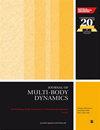用户自定义的高脉冲频率采集模型,用于机械损伤识别
IF 1.9
4区 工程技术
Q3 ENGINEERING, MECHANICAL
Proceedings of the Institution of Mechanical Engineers Part K-Journal of Multi-Body Dynamics
Pub Date : 2023-02-16
DOI:10.1177/14644193231157176
引用次数: 0
摘要
在过去的几十年里,时频方法在模态识别和结构健康监测领域得到了越来越广泛的应用。TF模型的一般和重大缺点是作为输出的分布和模糊的频率分量。为了克服初始TF技术的缺点,受影响的振动特征中包含的模态分离最终发展。最常用和首选的技术可以称为经验模态分解(EMD)及其变体。然而,这些变体与基本框架一起具有多模态倾向,这进一步迫使整个损伤识别过程的扩展。这项工作提出了一种用于结构损伤识别的时间演化,广义和高脉冲频率采集模型的发展。为了满足上述结果,变分模态分解(VMD)被认为是一种基于优化的信号分解工具,它利用了生成的模态响应的内容。本工作还旨在探讨VMD在以下几种情况下用于结构损伤识别的适用性:旧ADA钢桥在各种损伤情景下的车辆诱发振动;三层剪力框架建筑模型。随着所提出的状态监测模型的验证,本文解决了稳定可靠的新型损伤指标(DI)作为提取的瞬时输出的统计变化的需求。所提出的DI作为瞬时输出比率的平均值,表明了结构产生稳定响应的相对能力。选择的输出是瞬时频率,相位和能量,考虑到描述测量响应的物理变化。所提出的DI明显地解释了所考虑的结构中有关因素与退化原因的物理关系。DI还反映了系统的剩余有用性,并为操作人员提供了安全方面的测量。所得结果能很好地适用于车辆运动引起的动载条件下的实际桥梁结构。本文章由计算机程序翻译,如有差异,请以英文原文为准。
User-defined high impulsive frequency acquisition model for mechanical damage identification
In the past few decades, time–frequency (TF) methods have become increasingly popular in the field of modal identification and structural health monitoring. The general and significant shortfalls of the TF models are the distributed and vague frequency components as an output. To overcome the cons of the initial TF technique, segregation of the modes incorporated within the affected vibration signatures evolved eventually. The most utilized and preferred technique can be named empirical mode decomposition (EMD) and its variants. However, these variants, along with the basic framework, possess the multi-mode tendency, which further compels the extension of the whole damage identification procedure. This work presents the development of a temporally evolved, generalized and high impulsive frequency acquisition model for structural damage identification. To meet the said outcome, variational mode decomposition (VMD) is considered an optimization-based signal decomposition tool that utilizes the contents of the generated modal responses. This work also aims to investigate the applicability of VMD for the purpose of structural damage identification for the following situations: the old ADA steel bridge under vehicle-induced vibration for various damage scenarios; a three-story shear frame building model. Along with the said validation of the proposed condition monitoring model, this paper addresses the need of stable and reliable novel damage indicator (DI) as a statistical alteration of the extracted instantaneous outputs. The proposed DI as the mean of the ratio of the instantaneous outputs collectively indicates the relative capacity of the structure to produce a stable response. The selected outputs are instantaneous frequency, phase and energy, taken into consideration to depict the physical alterations in the measured response. The proposed DI evidently explains the physical relation of the involved factors with the degradation causes in the considered structure. The DI also reflects the remaining usefulness of the system and provides the measurements in safety aspects to the operators. The results so obtained are well competent for real bridge structures under the influence of dynamic loading conditions induced by vehicle movements.
求助全文
通过发布文献求助,成功后即可免费获取论文全文。
去求助
来源期刊

CiteScore
4.10
自引率
11.10%
发文量
38
审稿时长
>12 weeks
期刊介绍:
The Journal of Multi-body Dynamics is a multi-disciplinary forum covering all aspects of mechanical design and dynamic analysis of multi-body systems. It is essential reading for academic and industrial research and development departments active in the mechanical design, monitoring and dynamic analysis of multi-body systems.
 求助内容:
求助内容: 应助结果提醒方式:
应助结果提醒方式:


